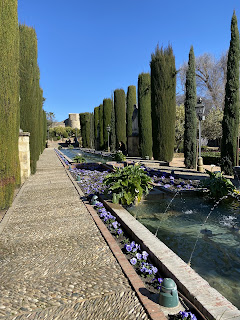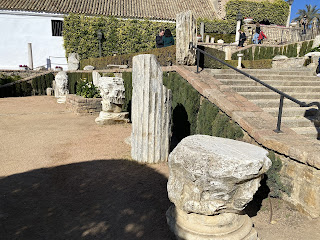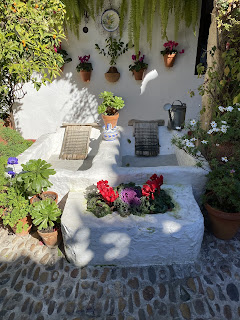Yesterday I mentioned that I had a difficult morning on Monday because for some reason this city of Cordoba reminded me of my sister. It didn’t really make any sense and I didn’t understand why. But there was just something about the spirit of this city that seemed to manifest the spirit of my sister. Today I found out why. I don’t believe in coincidences. Let me explain. Early this morning I met with a private tour guide that I had scheduled back in December. She took me to the mosque-cathedral, the synagogue, and the Alcazar or Palace of the Christian Kings as well as many other places. I’ll share pictures later in this post. Throughout the tour my guide pointed out many points of interest. One of them were peacocks - carved into woodwork in the Cathedral, on a marble sarcophagus, and in the mosaic flooring as well as other places - spanning nearly 1,000 years. My tour guide said that the peacock was a symbol of eternal life and used by nearly all the inhabitants of the area over the many years; the Romans, the Moslems, the Jews, and the Christians due to the cross cultural influence of one another here in Cordoba. Here’s why I don’t believe in coincidences - my sister LOVED peacocks and had many of them in various forms in her home! While my sister resides in heaven, her spirit is also alive and well for all eternity in this city of multiple cultures and my heart will now always be here in this sister city of mine. Here are a few of those peacocks that I took pictures of:
Today’s tour was full of so much history and information, it’s difficult to explain it all. And I took a lot of pictures. So I will simply list them by category. The first place we went was to the Mezquita Santa Iglesia Catedral. This is the Mosque that was built over an ancient church that was turned back into a cathedral. Underneath the floor, you can see the remnants of the original church from the 6th Century. When the Moors moved into the area, they built a Mosque over top of that. At one point in Cordoba’s history there were 1,000 mosques with 2 million inhabitants in the city and surrounding area. This was the largest and could seat 45,000 worshippers. It is massive inside. When the Christians invaded from the north and took control of the Andalusian area, they expelled all the Moslems and Jews and worshipped in the mosque for 200 years creating a Christian worship area. However, one of the later bishops petitioned King Charles V to build a grand Cathedral in Cordoba. Rather than tear down the Mosque, they simply built the Cathedral inside of it. First pictures are the early church. Second set of pictures are of the mosque and the third set are the Cathedral.







































































No comments:
Post a Comment